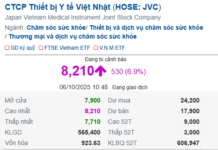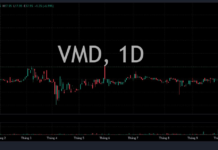The government, educational institutions, and businesses have proactively developed specific roadmaps to address the challenge of supplying high-quality human resources with the expectation of putting Vietnam on the global microchip supply chain map.
Human resource training – a strategic direction for developing the microchip sector in Vietnam
According to the Semiconductor Industry Association (SIA), the global semiconductor industry revenue reached USD 526.8 billion in 2023 and is expected to grow by 13.1% in 2024 to nearly USD 600 billion and USD 1,000 billion by 2030. With the advantages of an abundant, dynamic young labor force; a stable political system; the support of the Government; a favorable geographical location in the region; and comprehensive, open cooperation with many major economies, Vietnam has great potential to become a promising link in the global semiconductor supply chain.

Revenue and annual growth rate of the global semiconductor microchip sector from 1996-2023
The expanding market has seen a growing number of large semiconductor microchip corporations investing/expanding their investments in Vietnam, following the wave of production base relocation to Asia, such as Intel, Synopsys, Samsung, Amkor, Qualcomm, Marvell, etc., creating a “talent drought” in Vietnam’s semiconductor industry. Economic experts estimate that approximately 5,000 – 10,000 skilled engineers are needed each year to meet new microchip production demands, whereas the current labor force can only meet 20% of the demand. Seizing the opportunity and market demand, the Government has assigned the Ministry of Planning and Investment to take the lead and coordinate with other ministries to research and develop a Project for Developing Human Resources for the Semiconductor Industry by 2030, with a vision to 2045, with the goal of training 50,000 engineers and experts for the semiconductor industry.
To develop Vietnam’s semiconductor industry commensurate with its existing advantages, investing in semiconductor human resource training is a strategic direction and the key to exploiting potential, leveraging advantages, and promoting the development of this billion-dollar industry in Vietnam. However, considering the industry’s specific requirements for high accuracy and product quality, labor productivity and skill level, human resource training cannot stop at basic programs but requires extensive efforts in both breadth and depth.
Expanding microchip semiconductor training from the university level – developing human resources in breadth
Currently, the number of engineers in Vietnam involved in the design, manufacturing, and packaging of chips is approximately 5,000. Therefore, meeting the expectations of industry development and the goal of having approximately 50,000 engineers in the semiconductor microchip industry within the next 5 years is not a simple task. It requires the combined efforts of many organizations, ministries, sectors, and localities, in which university educational institutions must be the backbone for building a foundation and rapidly increasing the number of personnel in this field. This is also the focus and top priority of higher education in 2024 and the following years, according to the Minister of Education and Training Nguyen Kim Son’s sharing with VnExpress about training human resources for the semiconductor industry.
Providing general and specialized knowledge about the semiconductor field, the university environment will be the cradle of equipping students and learners with basic knowledge, helping them have a general picture of the industry, visualize future jobs, and build a solid foundation to be ready to develop skills and quickly grasp the work in a practical working environment. As of early April 2024, out of nearly 100 universities nationwide that have announced enrollment information, more than 10 universities plan to open new majors in Microchip Design – Semiconductor Technology or equivalent, including: Hanoi University of Science and Technology, Phenikaa University, Danang University of Science and Technology, Ho Chi Minh City National University, etc.
In line with the policies of the Government and the Ministry of Education & Training, in the 2024 – 2025 academic year, among 14 newly opened majors, Phenikaa University has announced enrollment information for the Microchip Semiconductor Design major with the goal of providing the labor market with highly skilled engineers, meeting the development needs of the industry. Assoc. Prof. Dr. Nguyen Van Hieu, Vice President of the university, said: “The university has prepared a team of experienced lecturers in microchip semiconductor design from both国内外, cooperating with a team of international experts, Vietnamese experts overseas to support teaching, and指导practical exercises. With the goal of training students with good capacity and the ability to adapt quickly to the business environment, the microchip semiconductor design major training program at the university will integrate copyrighted modules developed by reputable microchip design companies.”
With the participation of educational institutions and the enabling policies of ministries and sectors, it is expected that in 2024, our country can enroll and train more than 1,000 students in the semiconductor microchip industry, mainly in microchip design and 7,000 students in related fields.
Focus on advanced training – developing human resources in depth (upskill)
Expanding the training scale to anticipate and promptly meet market demands is an urgent requirement. However, increasing the quantity must go hand in hand with advanced training to ensure the quality of output, ensuring that learners and students are fully equipped with specialized knowledge and work skills in new fields with high human resource demands. Vietnam has the advantage of a young, dynamic, hard-working, creative, and technology-savvy workforce. However, for human resources to become a high-quality, sustainable resource that meets the recruitment needs of businesses in this specific field, practical experience plays a decisive role, in addition to being equipped with basic knowledge. Personnel need to be deeply involved in the process of practicing, interning, and solving practical problems as soon as they have basic knowledge, thereby quickly improving their skills and accumulating experience.

To train high-quality human resources for the semiconductor microchip industry, it is necessary to focus on training through practice, experience, and skill enhancement (upskill)
To create a practical environment and develop specialized skills for students, in addition to the teaching staff, educational institutions need to equip machinery and equipment, software tools, and standardized, advanced laboratories to simulate practical work effectively with a relatively large investment budget. This is not an easy task for many formal training institutions. Besides, a university training program requires 4 – 5 years for students to be trained from scratch, have basic knowledge, and develop an industry mindset, which is not a short period of time. Therefore, to realize the goal of expanding the scale and quality of the semiconductor microchip industry in the next 5 years, the solution of calling for investment from businesses and developing upskilling training programs, advanced training in microchips, in addition to long-term programs, needs to be focused on and will determine the level of proficiency and the ability to convert semiconductor human resources from related industries.
Sharing more about the training cooperation direction of Phenikaa University, Assoc. Prof. Dr. Nguyen Phu Khanh, Vice President of the university, said: “As a university following the experience and innovation model, in addition to basic knowledge and思维training, Phenikaa also focuses on building internship and practice pathways in a real/simulated environment through international cooperation programs and cooperation with businesses so that students can participate in solving practical problems as soon as they leave school. The Phenikaa Microchip Semiconductor Design Training Center will cooperate with major partners/corporations in the semiconductor field so that the trained workforce (from 3 months to 12 months) will achieve a high level of proficiency and deep specialization, meeting the immediate work requirements of employers”.
Phenikaa’s goal is not only to participate in solving the shortage of semiconductor human resources in the country but also to strive for international standards so that learners are ready to participate in the global market. To achieve this goal, Phenikaa invests heavily not only in facilities, equipment, professional, and modern software, such as the world’s leading advanced virtualization systems HAPS, Zebu, GPU, etc.; but also pays special attention to people – the decisive factor in this field, with a team of实战lecturers who are leading experts and engineers both domestically and internationally, and a tightly connected network with major partners/companies both国内外.
It can be seen that high-quality human resources are not only a competitive advantage in the “race” to attract investment in semiconductors but also





































